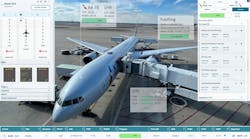Management Matters
Computers
Just another tool?
By Brandon Battles
October 2004
If you?ve had a recent unpleasant experience with your computer, then you probably have a whole different perspective about this question than what I had originally intended. Bad experiences tend to sour our outlook for just about anything, whether it?s a bad experience in sports, with a restaurant, or with the in-laws. And, as with most experiences good or bad, you have a choice. For example, if you aren?t too good in a particular sport, you can choose not to play it anymore. You can choose to give a bad restaurant another chance or not. I?ll leave the in-law situation alone.
But with computers, whether you?ve had a bad experience or not, you don?t have a choice. Computers are here to stay and represent an essential tool in every organization. What is it that makes computers so essential? Computers are tools that improve or should improve the efficiency of accomplishing the various tasks that occur in your organization. Two examples will help to illustrate what that statement really means.
Flying and maintenance aid
In most types of aircraft, a variety of computers and the related software
surround a pilot as he or she performs the tasks of flying. One such
computer application is TCAS (traffic collision avoidance system).
In essence, the computer receives, analyzes, and converts basic data about
other aircraft locations into useful information for the pilot during flight.
While some will argue that the original generation of TCAS may not have
represented a significant improvement over the older original method of ?avoidance
by sight,? few would argue that the current versions of TCAS, employing
various types of computers, don?t improve the efficiency of aircraft
avoidance.
The maintenance department also enjoys the benefits derived from computers. On the aircraft, computers will capture important parameters about an engine?s performance. When the maintenance technician eventually downloads the data, another computer will convert the data into information, information that will guide the technician?s maintenance activities. Generally, capturing engine performance data on computers and analyzing the data trends has enabled the maintenance department to migrate from hard time maintenance intervals to intervals based upon performance. Again, the computer has assisted in improving the efficiency of maintaining the aircraft.
There are many more examples of computer applications that improve the efficiency of the maintenance department. For the most part, maintenance personnel readily accept the use of computers into their daily activities, which hasn?t always been the case. Two reasons explain this acceptance. First, changing technology in aviation demands it. The previous example illustrates this point. If technicians want to maintain today?s aircraft then they must know how to use computers. Second, the computer and its related applications reside in an area of interest for technicians, the technical or mechanical aspect of maintaining a piece of equipment.
As a managerial tool
However, there is an area in the maintenance department where computers
are not as readily accepted. Based upon personal observations, maintenance
managers and technicians have been slower to accept the use of computers
as a managerial tool in the business processes of the department.
Why? The objective of using the computer is not as clearly defined as
in the technical areas and the software offers more flexibility, which
means a longer period of time associated with turning the computer and
its application into a useful productive tool.
How is it not as clearly defined? Using the previous application with engine performance data, typically the technician will follow very specific steps to access and then analyze the data. In essence, the technician will turn on the computer, select the appropriate program, and execute a specific set of commands each time the data is downloaded and analyzed. Rarely will the technician deviate from this predefined process.
Conversely, if you want to develop a tool to develop a budget, the likely starting point is a blank spreadsheet. Where do you begin? Eventually you will reach an established process like that just described but first you must know how to use a spreadsheet, which means knowing the relevant basic commands of the software. Once you accomplish that, which takes time, you must design your spreadsheet. Design means you will have choices or flexibility and if you?re like me choices mean more development time. A lack of readily available training that is condensed and focused also complicates your situation and extends the timeline before you have a tool for creating your budget. By the way, it?s also helpful in this scenario to know the basics about computer hardware and the relevant operating system.
Advantages of computers & automation
Based upon these examples it?s easier to understand why the use of
computers in business processes has been slower to develop in maintenance
departments. However, despite this situation, managers in maintenance
must recognize the importance of this tool and the efficiencies that it can
bring to their operation. If you are trying to decide whether or not to take
the plunge, listed below are a few of the benefits that computers and the
related automation will bring to your organization.
Computers allow the manipulation of large amounts of data quickly. Using our previous example concerning engine performance, a typical software program will capture many measurement points frequently, which will turn into a large amount of data in a short period of time. However with adequate processing capabilities, the computer can analyze the data quickly and supply meaningful information to the maintenance department in a timely manner. Working with the same amount of data manually would be impractical if not impossible.
As it relates to a business process, let?s examine how a computer could prove useful when compared to a manual system. Let?s assume that you had a software program that captured data about purchase orders. In a surprise move at mid-year, the financial folks happened to ask about the activity, in total dollars ordered, associated with your largest vendor.
With a manual system you would have to pull the file folder for the vendor in question (assuming your files are organized by vendor) and add the value associated with each purchase order using your calculator. Numerous interruptions due to your daily routine responsibilities would make the calculations even more difficult to accomplish. If you are exceptional, you will compute the total correctly the first time. If you are human, it will take several attempts before you have the confidence to respond to the financial folks.
With an automated system, you can take a couple of minutes to establish the filters that will yield the necessary information about the vendor. With the push of a button, the computer will crank through the data and in a relatively short amount of time will generate the answer, correctly. The automated system has saved you time and generated an accurate answer.
Computers can reduce the time associated with data input. Once again I will use the purchase order to illustrate this statement. When generating a purchase order certain basic information must be included, such as the vendor?s information and, for each line item on the purchase, the part number and description of the part. Using a manual system, each time you create the purchase order you would have to write the vendor?s name, address, and other contact information, and the entire part number and corresponding description. If you generate a large number of purchase orders, then this type of activity can consume a disproportionate amount of time.
An automated purchase order system can reduce this time requirement. Rather than entering all of the information about the vendor, identifying the vendor from a drop down list should fill in the address and other contact information automatically. For each line item of the purchase order, a few keystrokes about the part number should identify the correct part and fill in the other relevant information.
The important point to remember about computers and related automation is that once you?ve entered data, you should not have to reenter it. This is true for any well-designed software program not just the example I have used about purchase orders.
Computers can reduce the risk associated with incorrect data input. Continuing with the purchase order example, automation should eliminate incorrect data input. In a manual system, you would have to write the part number each time you order the part. Given the hectic pace for most inventory folks and the lengthy nature of part numbers in aviation, the odds are fairly high that transcription errors will occur. And the potential penalties associated with incorrect orders can be high both in terms of dollars and time as it relates to an aircraft that is unavailable.
An automated purchase order system can reduce the risk associated with transcription errors. As stated previously, once you have entered data into an automated system, the same data should never have to be entered again. By eliminating the number of keystrokes, the risk of error decreases.
Data on computers is accessible from multiple locations. Using our earlier example concerning the finance department?s request for vendor information, computers can access data from more than one location. In a manual system, the finance department more than likely has to work through the maintenance department to accomplish its task. The finance department is dependent upon the maintenance department?s schedule and the maintenance department is forced to divert its attention from its primary objective of maintaining aircraft.
With an automated system and the proper access, the finance department could answer its question quickly and without bothering the maintenance department. As mentioned previously, the finance department would also have an accurate answer.
Training is an essential ingredient
I realize that my examples may not directly apply to your situation
but hopefully you can see why computers have become an important
tool to use in the maintenance organization in the area of business processes.
They offer advantages that are hard to ignore. But to realize the
advantages, unfortunately you must learn how to use computers. In this
respect, as one of my colleagues likes to point out, computers are no
different than any other tool in your toolbox. And to learn how to use
a tool properly, training is required.
There is not one correct approach when it comes to computer training but the following are ideas that you may want to keep in mind as you prepare yourself and the maintenance department for a more extensive use of computers.
Due to the nature of computers, training needs to cover a variety of areas. The term computers as I have used it for this article is generic and actually represents several components of an automated system. Basically, computers break down into two components, hardware and software. Software breaks down further into operating and application software. As you can imagine computers are similar to maintaining aircraft, specialties will develop due to the enormity of knowing it all.
If you are in a larger organization, your required knowledge will probably be specific to the software application that you will use most frequently. If you are in a smaller organization, then your knowledge will have to be more general and will need to encompass hardware and operating software as well as application software.
In either type of organization, it does not hurt to have a general knowledge about hardware and software. No matter how specialized the software is that you work with, invariably you will find yourself in a situation where you will need to know more. Learn how your very specialized piece fits into the larger situation. Even if you have an information technology department to take care of various computer issues and while it may not want you experimenting on its computers, the folks in that department will appreciate working with someone that has a basic understanding about computers. A basic understanding will make troubleshooting go more quickly and give you your tool back. (Believe me, computers and the related software are not perfect and the more knowledge that you have, the better.)
Training is the most effective when you have the need to apply it. This statement is not true just for computers. As with any subject, if you don?t have the opportunity to apply what you have learned, you will forget it. I have probably forgotten more about the various commands in spreadsheets and word processing software that I received in training courses than I have retained. The simple reason is that I did not have a current use for ?tricks? that I learned. However, there?s a fine line.
If you don?t receive some form of training initially, then it would be difficult for you to determine the opportunities that you have. So really training needs to come at different times. As with most professional certifications, intense training occurs initially supplemented by periodic training that keeps the individual current. I am not suggesting intense computer training but initial training that provides an overview is important. And then once you have selected specific software and are implementing it in your organization, more training is a good idea.
Various types of training do exist. Various factors can affect the type of training that you may eventually need or receive. I would like to focus on three sources and they do not appear in any order of importance.
First is self-paced, self-taught training. This type of training can occur with a trial-and-error approach on the computer or by utilizing instructional books. Instructional books might be a good form of training for those of you that have a general knowledge but now have a specific application such as developing a budget on a spreadsheet. While help functions within a program are useful, instructional books generally are more informative. This form of training offers you the most flexibility but normally takes a longer period to accomplish because most will try to work it in as time becomes available.
A second source of training is offered by local organizations. These classes tend to be general in nature (i.e. an overview of a software application), are short in duration, and normally inexpensive for the information that you receive. Additionally, if you have a good instructor, then you have established contact with someone that may be able to help you on a more specific project at a later time. Community colleges, local computer stores, and local training organizations are common sources for this type of training. Normally training of this type will last a half or full day, which makes them easier to attend due to the shorter time commitment.
A third source of training is for the individual that has some very specific needs on specific software. Intense training is another way to describe this type of training. Perhaps you have purchased specific software for your organization such as inventory. You may want one or two individuals to become your experts so you choose to send them to training with the vendor for intense training that could last a few days or a couple of weeks. Training with the vendor in this case is probably the best alternative because the vendor knows the software the best and the application is so specific that general training from other sources does not exist. Unfortunately, you will lose someone?s contributions for a period of time but in the end the training received will be well worth it.
Recognize computers for the value that they can bring to your organization. As with any new tool, change is not always welcomed. Frequently the cool reception is related to the unknown. If computers do not fall into the normal scope of your responsibilities, then they will remain an unknown. But as the manager of your organization it is your responsibility to make sure you use tools that make the best use of your limited resources. Make sure you examine your opportunities and when you chose the computer as your tool, see to it that everyone receives training. If you do so, accomplishing your organization?s objectives should become easier.
Brandon Battles is a partner with Conklin & de Decker. He has spent more than 15 years in aviation working with maintenance organizations in the areas of cost collection and analysis, systems review, inventory analysis, and management training.




